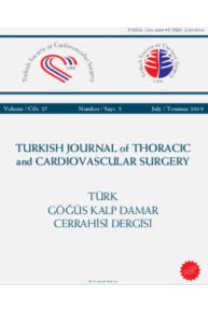Transcatheter closure of the aortopulmonary window in a three-month-old infant with a symmetric membranous ventricular septal defect occluder device
___
- 1. Jacobs JP, Quintessenza JA, Gaynor JW, Burke RP, Mavroudis C. Congenital Heart Surgery Nomenclature and Database Project: aortopulmonary window. Ann Thorac Surg 2000;69(4 Suppl):S44-9.
- 2. Stamato T, Benson LN, Smallhorn JF, Freedom RM. Transcatheter closure of an aortopulmonary window with a modified double umbrella occluder system. Cathet Cardiovasc Diagn 1995;35:165-7.
- 3. Campos-Quintero A, García-Montes JA, Zabal-Cerdeira C, Cervantes-Salazar JL, Calderón-Colmenero J, Sandoval JP. Transcatheter device closure of aortopulmonary window. Is there a need for an alternative strategy to surgery? Rev Esp Cardiol (Engl Ed) 2019;72:349-51.
- 4. Trehan V, Nigam A, Tyagi S. Percutaneous closure of nonrestrictive aortopulmonary window in three infants. Catheter Cardiovasc Interv 2008;71:405-11.
- 5. Sabnis GR, Shah HC, Lanjewar CP, Malik S, Kerkar PG. Transcatheter closure of large aortopulmonary window in a neonate. Ann Pediatr Cardiol 2018;11:228-30.
- 6. Pillekamp F, Hannes T, Koch D, Brockmeier K, Sreeram N. Transcatheter closure of symptomatic aortopulmonary window in an infant. Images Paediatr Cardiol 2008;10:11-7.
- 7. Uçar T, Karagözlü S, Ramoğlu MG, Tutar E. Transcatheter closure of aortopulmonary window with Amplatzer duct occluder II: additional size. Cardiol Young 2020;30:424-6.
- 8. Fiszer R, Zbroński K, Szkutnik M. Percutaneous closure of an aortopulmonary window using Amplatzer Duct Occluder II: Additional Sizes: the first reported case. Cardiol Young 2017;27:812-5.
- 9. Kosmač B, Eicken A, Kühn A, Heinrich M, Ewert P. Percutaneous device closure of an aortopulmonary window in a small infant. Int J Cardiol 2013;168:e102-3.
- 10. Odemis E, Guvenc O, Saygi M, Demir IH. Closure of aortopulmonary window using Nit-Occlud® PDA-R device in a 3-month-old infant. Pediatr Int 2016;58:754-6.
- ISSN: 1301-5680
- Yayın Aralığı: 4
- Başlangıç: 1991
- Yayıncı: Bayçınar Tıbbi Yayıncılık
Endovascular balloon angioplasty for infrainguinal arterial occlusive disease: Efficacy analysis
Mehmet Cahit SARICALIOĞLU, Bahadır AYTEKİN, Görkem YİĞİT, Anıl ÖZEN, Hakkı Zafer İŞCAN
COVID-19 presenting with diarrhea in a heart transplant patient
Mehmet Emirhan IŞIK, Deniz GÜNAY, mehmet aksüt, Şirin MENEKŞE, Yeşim UYGUN KIZMAZ, MEHMET KAAN KIRALİ
Bülent Mustafa YENİGÜN, Yusuf KAHYA, Çiğdem SOYDAL, Nihal Ata TUTKUN, Gökhan KOCAMAN, Muhammed Emre KOÇAK, Elgin ÖZKAN, Serpil DİZBAY SAK, Ayten KAYI CANGIR
Davud YAPICI, MUSTAFA AZİZOĞLU, Ali ÖZDÜLGER
Non-intubated video-assisted thoracoscopic bullectomy by paravetebral block and sedation
Şevki Mustafa DEMİRÖZ, Göktürk FINDIK, Ramazan BALDEMİR, Ali ALAGÖZ
Antegrad beyin perfüzyonu: Güncel uygulama hakkında derleme
The effects of amantadine on lung tissue in lower limb ischemia/reperfusion injury model in rats
Mustafa ORHAN, Ayça Taş TUNA, Yusuf ÜNAL, Mustafa ARSLAN, hayrullah yazar, Şaban Cem SEZEN, Sezen Irmak GÖZÜKARA, Onur PALABIYIK
A rare cardiac tumor presenting with myxoma: Primary cardiac hemangioendothelioma
Ertürk KARAAĞAÇ, Nihan YEŞİLKAYA, Tahsin Murat TELLİOĞLU, Fulya ÇAKALAĞAOĞLU ÜNAY, Yüksel BEŞİR
